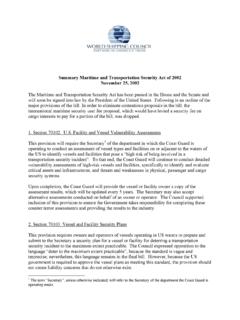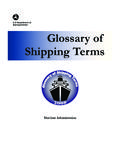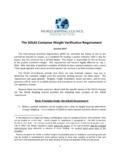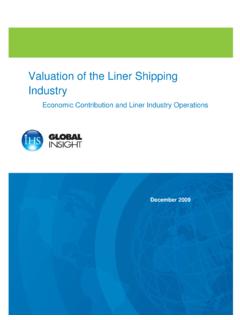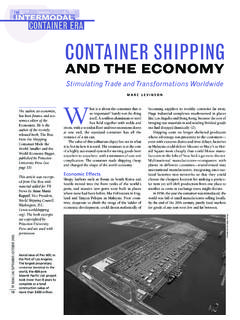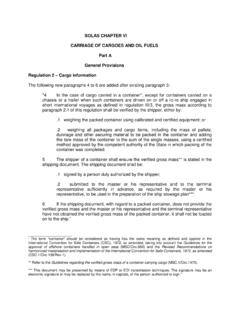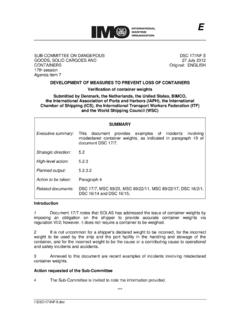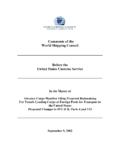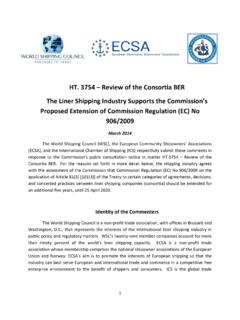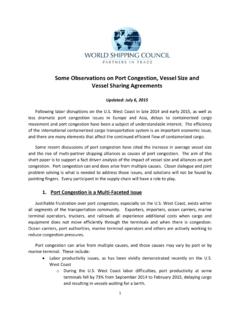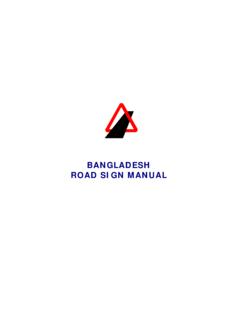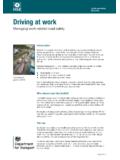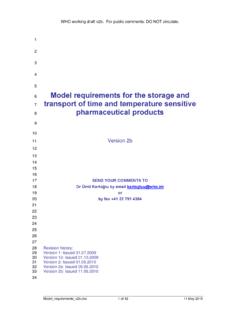Transcription of Safe Transport of Containers by Sea - World …
1 safe Transport of Containers by SeaIndustry guidance for Shippers and container StuffersInternationalChamber of ShippingSupported byIn December 2008, the International Chamber of Shipping (ICS) and the World Shipping Council (WSC), published safe Transport of Containers by Sea: Guidelines on Industry Best Practices . The Guidelines have been produced to minimise the dangers to containerships, their crews, and all personnel involved with Containers throughout the Transport chain, and were developed by an expert industry working group, meeting in London and Washington DC during 2008. The Guidelines have now been presented to governments at IMO where they have been well received.
2 Encouragingly, the Guidelines have also attracted a positive response from shippers organisations who, under the umbrella of the Global Shippers Forum (GSF), have lent their support to this primary responsibility for the safe Transport of Containers by sea rests with containership operators. However, there are many other parties in the Transport chain concerned with the safe movement of Containers . There are those employed by shipping lines involved with the booking and assignment of cargoes, and the subsequent arrangements for stowage planning; and there are the freight forwarders, ports and terminal operators and - particularly important - the shippers, from whom the cargo originates.
3 All of these players have important responsibilities which are addressed by the Industry emphasis is given by the Guidelines to the responsibilities of those involved with the correct packing, labelling and weighing of cargoes when they are stuffed into Containers , and the accurate declaration of goods by cargo interests. safe Transport of Containers by SeaComprehensive information on the safe stuffing and Transport of Containers can be found in the joint International Chamber of Shipping and World Shipping Council publication safe Transport of Containers by Sea: Guidelines on Best Practices .To order, see back page or contact your maritime of these activities have a direct bearing on the safety of ships and the reduction of the risks to the lives of ships crews and other personnel in the Transport following advice is an extract from the main guidance on shippers responsibilities addressed in the safe Transport of Containers by Sea OverviewThis guidance is addressed primarily to shippers, although everyone involved in the Transport of Containers by sea, not least ship operators and crew, should be aware of the importance of stuffing Containers safely and correctly.
4 And the need to comply with international regulations and best practice procedures established by the industry. In the interests of protecting cargo, this is a matter of enlightened self is of the utmost importance to recognise that actions taken when Containers are stuffed may have direct implications for the stability and safety of containerships, the lives of seafarers on board and the safety of others throughout the Transport is particularly important for all involved to understand the high degree of physical risk presented by the marine environment, the extreme forces to which a ship is exposed at sea, and the extent to which these risks are greatly increased by any failure to stuff Containers correctly.
5 This point cannot be over is vital to adhere to weight restrictions, and correct procedures for loading and securing cargo, to ensure the safe distribution of weight and that cargoes inside Containers do not move or shift when at sea, compromising the safety of the IMO/ILO/UNECE Guidelines on the Packing of Cargo Transport Units provides a common global resource for information on container Key RequirementsThe following requirements must be adhered to during container stuffing/unstuffing, in addition to the more specific observations elsewhere in this leaflet: Subject to booking request, select the most suitable container type to accommodate the cargo; Prepare a pre-stow plan before commencing stuffing so that weight/volume considerations are covered and point loading limits are observed; Never load by weight above the payload limits of the container , the cargo and container net weight must not exceed the container s gross safe working load; Never load by weight above the road regulations applicable on the transit; Distribute the weight of the cargo evenly over the floor of the container .
6 Never stow heavy items in one section and light items in another. The weight of the cargo should not exceed the 60% within half the length rule ; Do not stow heavy goods on top of light goods; Stow and secure all cargo tightly; Observe all the handling instructions on cargo such as Do not drop or This side up ; Stow goods with sharp corners separate from other softer merchandise. Use dividers and separating material as appropriate; Where possible with mixed loads, place packages containing liquid cargo on the bottom tiers with dry cargo on top; Use cargo liners for obnoxious cargo such as hides and carbon black; Do not use clamps or other loading devices unless the goods can withstand them; When loading Dangerous Goods, ensure that the IMDG Code packaging requirements are always observed; Do not load goods in a container with damaged packaging; Do not stow wet and damp goods with dry goods; Do not use dunnage or packaging which is incompatible with the cargo.
7 Do not stow goods with tainting odours with sensitive merchandise; Observe all rules concerning dangerous cargo. Use appropriate labels and placards to identify packing and freight Containers loaded with Dangerous Goods; Stow hazardous cargo near the door where possible; Include all necessary documentation; Record the seal number and the container number on all shipping documents; Never smoke, eat or drink during loading or Checking the ContainerIn most operational regions, Containers are inspected when they return after import but not again when they are released for export. There will also be instances of triangulation moves when the container is driven by truck straight from the import customer to the export customer.
8 In such cases, the container will probably have only received a quick sweep out and check for damage by the full container inspection for structural damage requires a competent and trained person. However, checking for cleanliness and general acceptability is a matter of common sense. It is very much in the interests of any user, regardless of whether the container is being stuffed with a full load, to carry out a quick internal and external inspection prior to stuffing (and also after unstuffing the container ).The following useful checklists should assist the examination of Containers during cleaning, loading and unloading, to help minimise cargo damage and reduce risks to personnel.
9 At all times, it is necessary to adhere to the IMO/ILO/UNECE Guidelines for Packing of Cargo Transport Pre-StuffingPrior to stuffing, a number of checks should Industry guidance for Shippers and container Stuffersbe made on a container both internally and externally to ensure that it is structurally sound, and safe to work in and around. Dated and digital photographs of the interior and exterior of the container should be External ChecksBefore a container is opened, it should be ensured that it possesses a valid container Safety Approval Plate and that the re-examination date has not passed. Once this has been established, the following aspects of the container s exterior should be assessed before it is opened or entered: Holes: No obvious holes or tears in the exterior panelling; Doors: No broken or distorted door hinges, locks, or door seal gaskets; Tilts (Tarps): Where Containers are fitted with removable roof tilts (tarps) or side curtains, they should fit correctly, be equipped with tilt wires and have no tears in the fabric; Roof bows: Open top Containers should have all the roof bows (supports) in place.
10 If the roof is of the retractable sort then the roof bows should slide smoothly to the ends of the container ; Placards and Markings: Any placards or markings remaining on the outside of the empty container which refer to the previous cargo should be removed; Structure: No serious structural defects such as torn or cracked corner fittings or side rails (IMO CSC/Circ. 134 contains guidance ). Internal ChecksOnce the external elements of a container unit have been agreed to be of a suitable standard, the container may be opened in order that the following checks can be made: Clean: No leftovers (sweepings, dust, grease or liquid) of the previous cargo; Dry: The interior should be dry and free of any sweat or frost; No infestation: There should be no evidence of pests, insects or rodents which might contaminate cargo and lead to delay by port health authorities.
